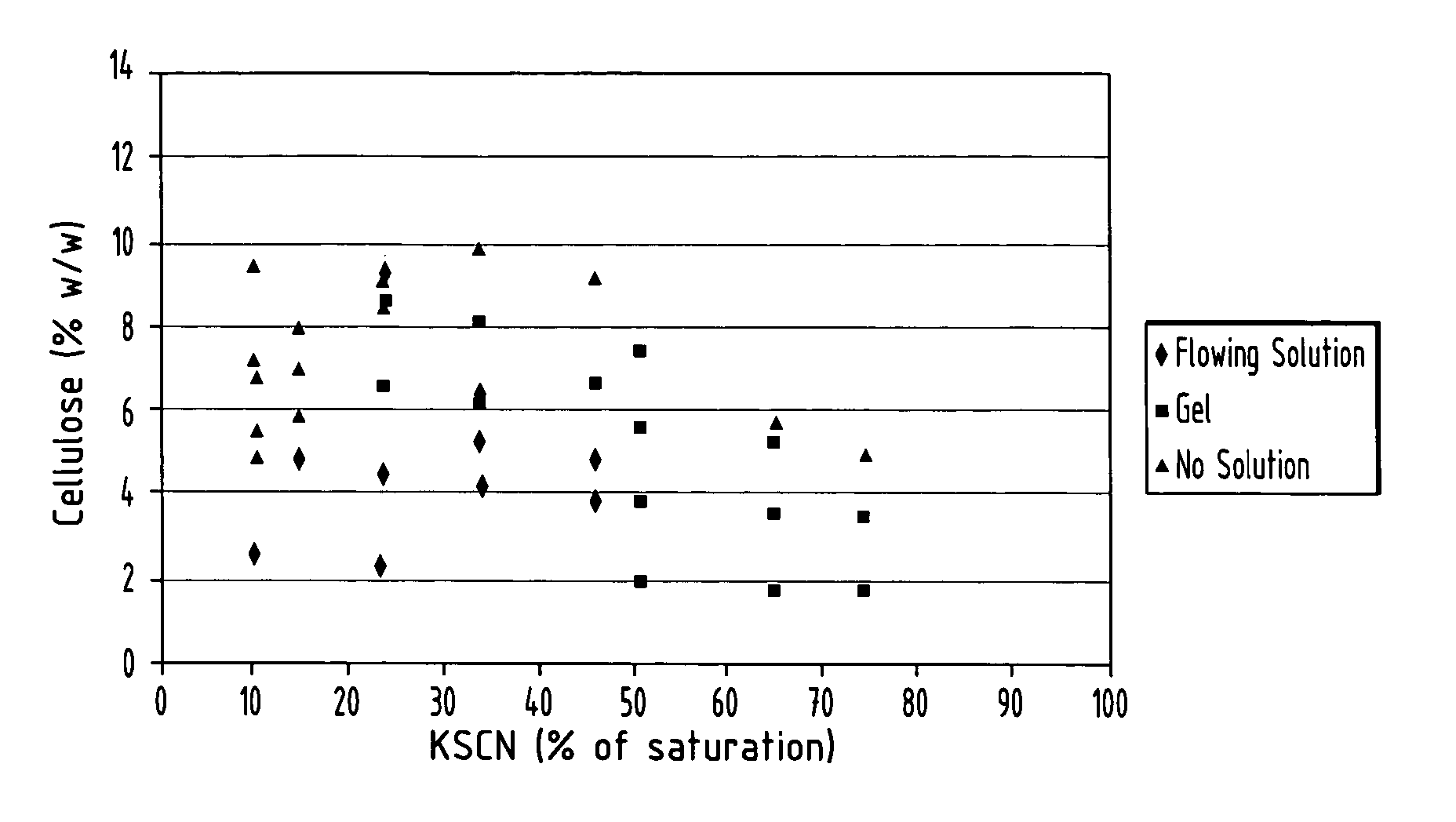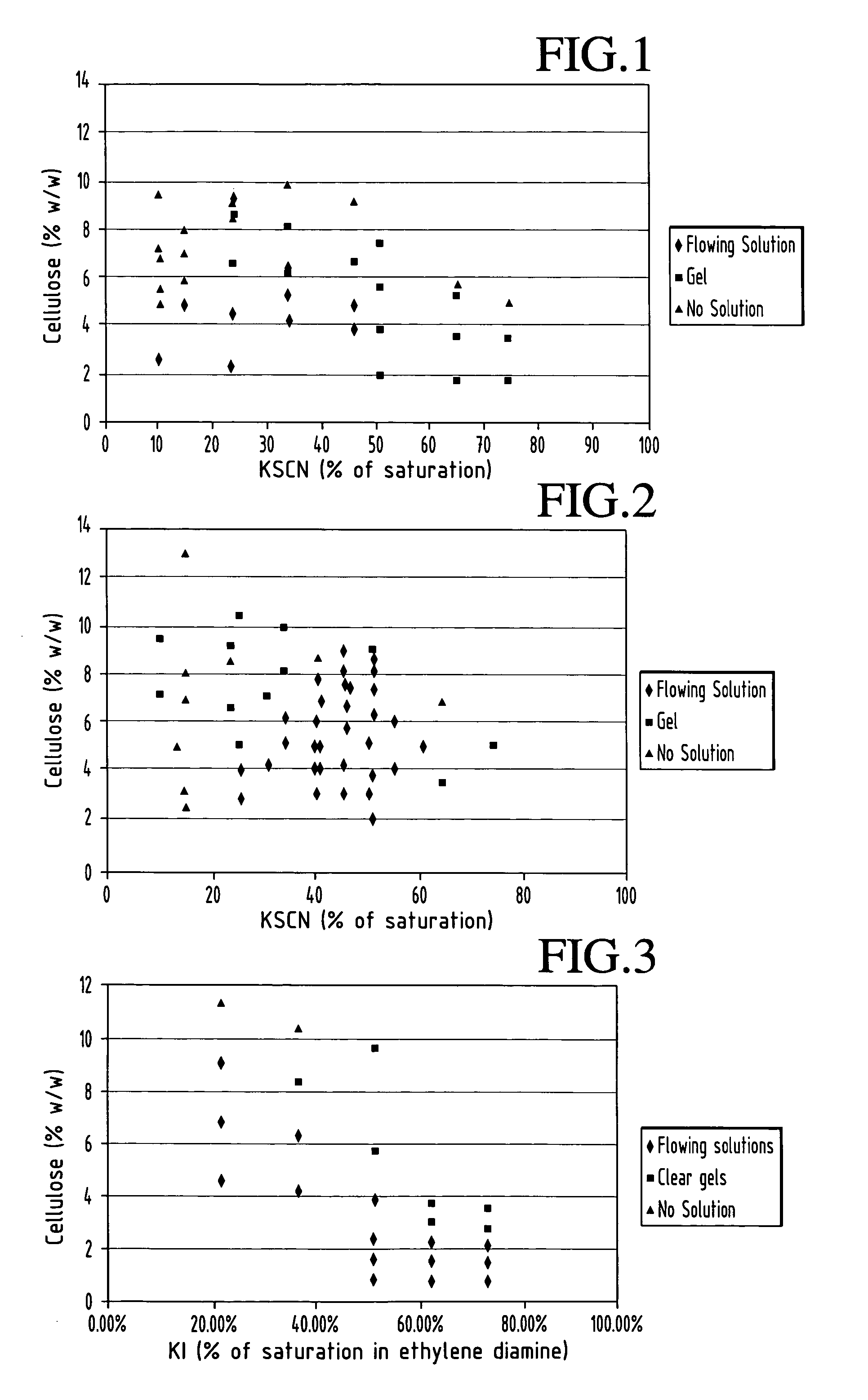Cellulose solution in novel solvent and electrospinning thereof
a technology of cellulose and novel solvent, applied in the direction of printing, filament/thread forming, fibre treatment, etc., can solve the problems of hydrazine being extremely toxic, difficult to dissolve cellulose without chemical modification and/or derivatization,
- Summary
- Abstract
- Description
- Claims
- Application Information
AI Technical Summary
Benefits of technology
Problems solved by technology
Method used
Image
Examples
working example i
[0023] Solvent of ethylene diamine and KSCN was used to dissolve cellulose using either a zero shear mixing method or a gentle shear mixing method.
[0024] The procedure for the zero shear mixing method in this working example was as follows:
[0025] A known amount of dried cellulose was placed inside a centrifugal test tube. 20 mL of ethylene diamine (C2H8N2) was then added to the test tube and mixed for 30 seconds using a Genie Vortex mixer. After the cellulose was well integrated with the liquid, a known amount of salt was added and mixed for an additional minute, inverting the tube once during mixing. If the sample still had clumps of salt, a metal rod was inserted into the tube to try to break up the clumps. When the contents appeared to be well incorporated, the test tube was placed into the freezer (−20° C.) for a minimum of 4 hours. When time had elapsed, the test tube was thawed in a 40° C. water bath for 30 minutes. The thawed sample was mixed for 30 seconds. Dissolution was...
working example ii
[0032] Solvent of ethylene diamine and KI was used to dissolve cellulose using the gentle shear mixing method.
[0033] In each case 9 ml of ethylene diamine was used.
[0034] The cellulose used was from cotton linter filter paper (DP of 940, determined using Cannon-Fenske Routine Viscometer as described above).
[0035] Results are shown in FIG. 3.
working example iii
[0036] Solvent of ethylene diamine and KSCN or KI was used to dissolve cellulose.
[0037] In each case, 20 ml of ethylene diamine was used. KSCN in amount of 6 g (40% of saturation), 5.2 g (35 % of saturation) or 4.5 g (30% of saturation) was used. KI in amount of 6.7 g (50% of saturation), 5.4 g (40% of saturation) and 4.0 g (30% of saturation), was used. Cellulose used was TEMBEC PULP HV1OA, a soft wood pulp (DP=2200, Mv=352,000), TEMBEC PULP HV2OA, a soft wood pulp (DP=2300,Mv=372,500, TEMSOL V, a soft wood pulp (DP=790, Mv=127,000) and TEMFILM HWD2, a hard wood pulp ((DP=815, Mv=131,000). DP was determined by the xanthate seconds method described above. Cellulose samples were ground to 20 mesh and dried overnight under vacuum.
[0038] Ethylene diamine was measured using a pipette. Cellulose, KSCN and KI were weighed and added. Samples were mixed thoroughly using gentle shear to ensure that all cellulose was wetted out and all salt was dissolved. After mixing, samples were a placed...
PUM
| Property | Measurement | Unit |
|---|---|---|
| degree of polymerization | aaaaa | aaaaa |
| degree of polymerization | aaaaa | aaaaa |
| temperature | aaaaa | aaaaa |
Abstract
Description
Claims
Application Information
 Login to View More
Login to View More - R&D
- Intellectual Property
- Life Sciences
- Materials
- Tech Scout
- Unparalleled Data Quality
- Higher Quality Content
- 60% Fewer Hallucinations
Browse by: Latest US Patents, China's latest patents, Technical Efficacy Thesaurus, Application Domain, Technology Topic, Popular Technical Reports.
© 2025 PatSnap. All rights reserved.Legal|Privacy policy|Modern Slavery Act Transparency Statement|Sitemap|About US| Contact US: help@patsnap.com


